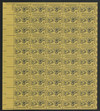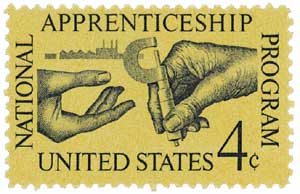
# 1201 - 1962 4c National Apprenticeship Act
National Apprenticeship Act
Apprenticeships have played a large role in America’s history. Apprentices learn important skills such as carpentry, masonry, shipbuilding, and more to contribute to our growing economy. Some of America’s founding fathers got their starts as apprentices – George Washington apprenticed as a surveyor, Benjamin Franklin as a printer, and Paul Revere as a silversmith.
For many years, apprenticeships were largely unregulated. The first state registered apprenticeship system was created in Wisconsin in 1911. Following the passage of the National Industrial Recovery Act (NIRA) in 1934, trade unions worked with the National Recovery Administration to establish “industry codes” relating to wages, working conditions, and apprenticeships in the construction sector.

The NIRA was deemed unconstitutional in 1935, however, so US Secretary of Labor Frances Perkins created the Federal Committee on Apprenticeship. This committee sought to continue the progress made in relation to construction apprenticeships. It consisted of representatives from several different federal agencies who were asked to research and promote new policies for apprenticeships.
In 1937, William J. Fitzgerald brought forth the National Apprenticeship Act (also known as the Fitzgerald Act). Fitzgerald had worked in a foundry (a factory specializing in casting molten metal) as a young man and knew the importance of apprenticeships. Congress passed the act, and President Franklin Roosevelt signed it into law on August 16, 1937. The act established standards for apprenticeship programs. It included regulations that protected the health and welfare of its members, and promoted the hiring of apprentices.

Early programs were focused on the fields of manufacturing, construction, and utilities. By the late 1940s they expanded to include firefighters, police, emergency medical workers, and other health and safety professionals. Current;y, there are nearly 30,000 Registered Apprenticeship programs with almost half-a-million apprentices.
Click here to read the act and its amendments.
National Apprenticeship Act
Apprenticeships have played a large role in America’s history. Apprentices learn important skills such as carpentry, masonry, shipbuilding, and more to contribute to our growing economy. Some of America’s founding fathers got their starts as apprentices – George Washington apprenticed as a surveyor, Benjamin Franklin as a printer, and Paul Revere as a silversmith.
For many years, apprenticeships were largely unregulated. The first state registered apprenticeship system was created in Wisconsin in 1911. Following the passage of the National Industrial Recovery Act (NIRA) in 1934, trade unions worked with the National Recovery Administration to establish “industry codes” relating to wages, working conditions, and apprenticeships in the construction sector.

The NIRA was deemed unconstitutional in 1935, however, so US Secretary of Labor Frances Perkins created the Federal Committee on Apprenticeship. This committee sought to continue the progress made in relation to construction apprenticeships. It consisted of representatives from several different federal agencies who were asked to research and promote new policies for apprenticeships.
In 1937, William J. Fitzgerald brought forth the National Apprenticeship Act (also known as the Fitzgerald Act). Fitzgerald had worked in a foundry (a factory specializing in casting molten metal) as a young man and knew the importance of apprenticeships. Congress passed the act, and President Franklin Roosevelt signed it into law on August 16, 1937. The act established standards for apprenticeship programs. It included regulations that protected the health and welfare of its members, and promoted the hiring of apprentices.

Early programs were focused on the fields of manufacturing, construction, and utilities. By the late 1940s they expanded to include firefighters, police, emergency medical workers, and other health and safety professionals. Current;y, there are nearly 30,000 Registered Apprenticeship programs with almost half-a-million apprentices.
Click here to read the act and its amendments.












